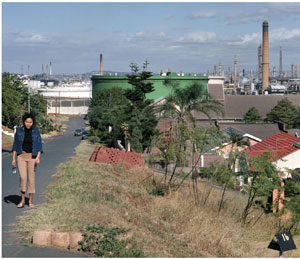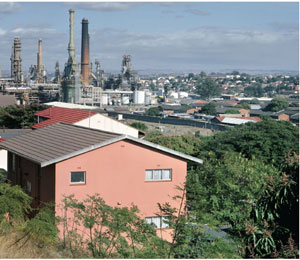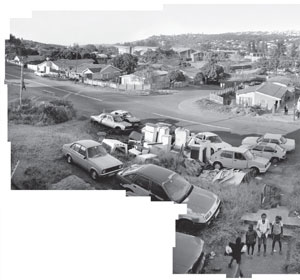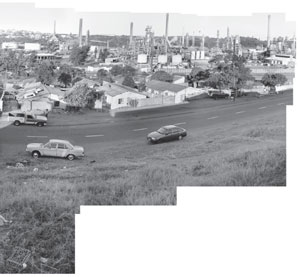Serviços Personalizados
Artigo
Indicadores
Links relacionados
-
 Citado por Google
Citado por Google -
 Similares em Google
Similares em Google
Compartilhar
Kronos
versão On-line ISSN 2309-9585
versão impressa ISSN 0259-0190
Kronos vol.35 no.1 Cape Town Nov. 2009
ARTICLES
Photographic portraiture, neighbourhood activism and apartheid's industrial legacy: reflections on the Breathing Spaces exhibition
Marijke du Toit; Jenny Gordon
ABSTRACT
Breathing Spaces: Environmental Portraits of Durban's Industrial South was shown in Durban Art Gallery in July 2007 and travelled to Cape Town's Iziko Gallery of Good Hope at The Castle in January 2009. The exhibition was the culmination of a project that was launched in 2002 and that focused on three adjacent neighbourhoods, Wentworth, Merebank and Lamontville.
From the start, our aim was to build a composite portrait of Durban harbour's residential-industrial hinterland, an area that bears the strong imprint of apartheid-era planning and a longer history of racial segregation. Lamontville, Durban's oldest African township, was established in 1934. Today it is next to an industrial area, Mobeni, and across the highway from most of Merebank and from Wentworth, where the stacks of the Engen oil refinery tower over surrounding council flats and houses. Other large industry includes the Sapref Oil refinery and the Mondi paper mill. Numerous smaller petro-chemical companies also add to the high levels of pollution of Durban's industrial basin. Many elderly residents have childhood memories of growing up in a semi-rural environment of wetlands, market gardening and relatively dispersed factories before the arrival of the petrochemical industry from the early 1950s.1 In the 1960s, as the Durban municipality realised its dreams for a racially segregated city and implemented Group Areas legislation, Wentworth was established right next to Durban's first refinery. This high density 'Coloured' working-class township was separated from the 'white', seaside neighbourhood, The Bluff , by a natural ridge and by thick bush, and from Merebank (declared an 'Indian' group area in 1958) by a single street. Racial and industrial zoning in South Durban also meant that many market gardeners of Indian descent lost their land.2
The starkly persistent geography of apartheid therefore drew us to choose this area for a photographic project, but we also chose to work in this part of Durban because it has a strong history of environmental activism.3 The southern industrial basin became a flashpoint in the fight for environmental justice from the 1990s, as the South Durban Community Environmental Alliance placed pressure on the main culprits - Engen, Sapref and Mondi - and claimed new spaces for civic intervention in order to reduce pollution. Urban planning has remained a matter of vigorous and often bitter contestation, as Durban's eThekwini Municipality has tended to be responsive to industry's desire for more land.4
Breathing Spaces was the culmination of an outward spiral of public presentations that included exhibitions in South Durban itself. We introduced ourselves to each neighbourhood by holding photographic workshops during the mid-year school holidays. Exhibitions that showed the work of photographic workshop participants were held in the municipal libraries of the respective neighbourhoods.5 The workshops created opportunities for Jenny to visit participants at home and take photographs. People who agreed to be photographed were given copies of their portraits - which then prompted neighbours and friends to participate. We asked activists and community workers to introduce us to matters of local concern, and to people whom Jenny should photograph. We also continued to work with a few volunteers from local organisations and community-based projects in-between workshops. They commented on Jenny's photographs in viewing sessions and helped to facilitate interviews with residents about the photographs, thus shaping the project in important ways. We chose the Durban Art Gallery for its proximity to public transport networks and because the gallery is part of a municipal complex of museums that is very well attended by black and working-class Durbanites. The opening of the exhibition at DAG was well attended by South Durban residents, and we arranged transport, particularly for people who had consented to be photographed and who had made their family photographs available for the exhibition.
The exhibitions of 2007 and 2009 were visually complex arrangements of photographs that combined different genres of photography: Jenny's portrait and landscape photographs were presented together with reproductions of personal photography sourced from residents, and photographs by participants from the workshops were also included. The backbone of both exhibitions was Jenny's photographs. Large panoramic landscape photographs (1.2 to 8 metres long) were displayed on the gallery walls. Portraits of people from the various neighbourhoods were arranged on metal exhibition stands (see-through wire grids in metal frame surrounds) positioned throughout the galleries. On some of the stands, Jenny's photographs were arranged together with reproductions of family photographs, mostly old studio portraits, sourced from residents, and other stands carried only family photographs. The work of participants in the photographic workshops was also included as part of the exhibitions. Both exhibitions also included a large and detailed photographic map of South Durban, placed on the floor of the gallery, together with newspaper articles that documented industrial pollution.
Descriptive text for each photograph identified people by name. A number of photographs were also accompanied by extracts from interviews, in which people who feature in portraits, their neighbours or family members responded to questions that attempted to explore personal meaning, memory and issues of representation. The exhibition at the Durban Art Gallery, in particular, provided ample opportunity for visitors to write comments. Tables (and oil drums positioned throughout the exhibition) had books and large sheets of paper - these had questions for visitors about how they responded to the photographs and to the exhibition as a whole. This approach prompted extensive written comments and discussion. Many responses were from residents of South Durban and surrounding areas.
The dialogue that follows is not a conventional interview, but has been constructed from written and recorded conversations between ourselves. This format allows us to retain our individual voices and to explore our various understandings of the project and the exhibitions. We chose to focus this discussion on Jenny's photographs and her approach to photography, as opposed to a focus on the reproductions of personal photographs and on photographs by workshop participants. This emphasis is also reflected in the selection of actual photographs.
MdT: When we started working together on this project in 2002, I remember tramping around Wentworth with you over those first weeks, and how intense the sessions of photography always were. You would be completely focused, and spend hours in a trance of concentration, while we also spoke to people, explaining the project and what you as photographer were doing. I've often thought about how you seem to attain a different sort of calm and focus behind the camera. But what is it that attracts you?
JG: In retrospect I think photography gave me an opportunity to discover the world. I came from a fairly sheltered background and using a camera meant going out into the world and discovering it for myself. It was a first-hand education and it remains a way of trying to understand people and society. It was during my second year at university in 1976 that I started doing photography. The previous year, I had definitely become much more aware of what was happening in the country and I was completely horrified and wanted to find a way not only to deal with it psychologically but also to communicate about it. In that first year of studying photography, I began to discover that people were my main interest. In the beginning I only had a 35mm camera. I then got my Rollicord - it's a square format camera and you look down into it to focus. It was a good fit as it enabled me to engage, talk and relate to people more easily, as my face wasn't behind the camera. I think that people can pick up if you are interested in them and their lives. Diane Arbus - who also changed to a similar format camera - once said that 'the camera is a license, people want to be paid that much attention.'6
MdT: Why do you think this is so, that you're primarily a photographer of people? When you first worked as a photographer in the late 1970s and 1980s, even though you wanted to record what was happening in the country, you didn't do hard news. In our past conversations, you've also identified yourself as a 'humanist', not so much in a specific ideological sense of the term, but to emphasise that when you take photographs and work out a new project, you do think about contemporary injustices and how you could engage with these.
JG: When I first started out as a photographer I was a student and not working for anybody. My first real introduction to photography was when I did a project for my fine arts photography course. I accompanied student doctors who were working in the shack settlement Crossroads, outside Cape Town, and who suggested that I photographed them at work. I started by taking pictures of the doctors. But I soon gravitated towards taking photographs of people sitting in their homes. I was always more interested in people and their living situations rather than action. This was also when I started to give copies of pictures to the people photographed by me.
I like the idea that 'humanism is inseparable from art, however defined and created', which is what Bill Jay writes about David Hurn in his book On Being a Photographer.7 I also think that passion must also be part of one's art. You must have passion for the subjects that you're photographing. David Hurn says that for him it's not simply about 'the craft of photography', but that 'photography is inextricably linked with life, the photographer is not invisibly behind the camera...'.8
The more I take photographs and teach photography, the more the process enthrals me. The philosophy of experiential learning which I apply in my teaching is also relevant to my own photography. I'm not obsessive about the technical aspects of photography for their own sake, but I am concerned about them to the degree that they support or convey the meaning of an image. I prefer a camera format that gives adequate detail, and I very rarely use wide angle or long focal length lenses, because I feel that these distort 'reality' in ways that can appear clever but do not necessarily add anything of genuine significance to an image. I do think that anyone can learn how to take technically proficient photographs, but I think you need a lot of passion to make both a technically skilful picture and a meaningful one. I am very concerned with connecting 'on a human level' with the subject of the photographs and with the 'feelings' that I am trying to communicate.
MdT: When I met you in the late '90s, you were teaching photography in workshops for children from a squatter camp near Hout Bay, Masiphumelele. Your previous, larger projects had all been about communities in one way or another - I'm thinking of your photographs of the Mai Mai Market in central Johannesburg and of people living in Troyeville. It's interesting to think about how our project relates to your previous work and how you also developed new ways of doing your photography. When we started to work together in 2002, we decided to put together a project that would involve photography workshops for first-time photographers who lived in the areas near the refineries - we thought of high school students as the participants. You would also be taking portraits, and I would find and make reproductions of family photographs. In the first few years of the project, I used to refer to an 'outsider'-'insider' dynamic when I explained the project to academic colleagues. I contrasted your position as a photographer from out of town, who visited for days or weeks at a time, and I also contrasted your portraits to those of the residents who were taking photographs as part of the workshops, of their own lives and their own neighbourhoods. But the different parts of the project became more and more interrelated, and we both worked in South Durban for several years. From my perspective as an academic, you pushed both of us to work with activists and community workers from various communities over an extended period of time.
JG: I have always seen myself as 'other' and not as belonging to a particular group. I grew up in a Jewish neighbourhood, but as my family was not traditional or religious, I didn't fit in. And therefore when I work in one or other place as a photographer, I don't photograph people because I see them as 'other' or as different from myself. For me, working within various communities and not going in with preconceived ideas about what I'm going to achieve and what the community is like are very important. Most of my work has been about communities, rather than individuals. Most of my teaching has also been in community situations, but it's only with the Durban project that my interests or passions started working together. The period of my life which had a big influence on me was the 1970s. I was very influenced by the ideas of transferring your skills and the concept of each-one-teach-one, and that I should avoid - horror of horrors - my own personal navel gazing.
Photographer Robert Frank once wrote in a grant application that 'the project I have in mind is one that will shape itself as it proceeds, and is essentially elastic'.9 For me this describes the learning journey that one embarks on when one starts a photographic project. I'm not working totally instinctively, I do plan, but I know that things could change at any moment. You'll remember that we looked for grassroots activists from the beginning, but this became more and more central to my way of working as I went on. If one starts work in a community as a new person, one has a really simple view of a place. One has to talk to people who've lived and worked in the area for years - they can know it in all its complexity. It was you who approached local organisations for volunteers who could be invited to participate in our photographic workshops.
MdT: That's how we came to know George Ruiters (community health care volunteer) and Lorna McDonald, whose son was in our first workshop and who later participated herself as a member of Women of Wentworth. Also Oliver Meth, who was still at school and very passionate about children's rights and also the environment, who approached us in the Austerville municipal library, at the first exhibition of photographs from our first workshop. And once we started working in Merebank we got to know Mrs Perumal, who took us to people in her neighbourhood who were suffering from asthma while telling us about her work as an anti-pollution and community health activist. And at our first exhibition in Lamontville, we met Jabu Ngcobo, who then became very involved with helping us get to know the problems faced by people in Lamontville and especially the minority of women living in the migrant labour hostels.
JG: They actually took me to places that for them were symbolic of problems that people in their neighbourhood faced and that they felt needed to receive public attention. George would be talking about the problem of living with Aids and poverty, while living in an area which was polluted. So as it evolved, the project was not only about a partnership with you, it was also one with George, with Oliver and a lot of other people. For me, one of the most inspiring aspects of the photographic project was getting to know all the community activists - people who were very often doing community work without getting paid. They all were unofficial social workers within their own communities and very aware of the need to educate people from their neighbourhoods - which is also what drew them to learn how to take photographs and to participate in the project.
MdT: Let's look at some of the photographs that resulted from these partnerships. I'm interested in what comes to mind when you look at them now. It was Mrs Perumal who took you to the people who live a few hundred metres from the Engen and Sapref oil refineries, and from the Mondi paper plant, and who suffer from chronic asthma. And George Ruiters took you to Latasha Webster's home in Austerville, because of his conviction that her chronic illness is also caused, or made much worse, by the pollution.
JG: When I first started taking portraits of people who had chronic asthma, I worried quite a lot about how I could communicate their experience, and often it was their idea to hold their pumps. Either they had them on them or they would get them because they were a symbol of their problems, I suppose. I hope that the photograph captured the feeling I had when I was there and taking it - Mrs Reebee was wheezing, she was quite frail but she was in her own home, in her own space. What also interested me was that she insisted on being photographed in her pyjamas while her daughter wanted her to change. I had a feeling that she was wanting me to communicate her ill health, her asthma. I don't know if it comes across that this is a woman from within her own culture, from one of the many South African cultures. She didn't speak much English. She lived in an area where she had her own friends and family, in her own small world, I suppose.
I had heard about Latasha Webster long before George took me to meet her. A lot of people talked about the fact that she lived in an area so close to the pollution, which made her illness harder to deal with. I had a long conversation with Latasha about her illness when I took her portrait. She showed me all her medication, going through what the different things were for. On top of everything else she suffered from asthma. And when I looked at the photograph afterwards I was very interested in the sympathetic and concerned look that her cousin was giving her, while Latasha was talking about her illnesses.
MdT: These were situations in which you were taken to family homes. We entered a very different context when we explained to Jabu Ngcobo that to our thinking, your photographs had still not dealt with social problems in Lamontville. She introduced us to the minority of women who lived in the Wema (S.J. Smith) Migrant Labour Hostel and were trying to improve the living conditions for women and children in the hostel. When we went to the Wema (S.J. Smith) Hostel, the environment was much less familiar to us both I think, and Jabu Ngcobo was careful to observe the protocol, to arrange and ask for permission to take the photographs, and to help us find from Lamontville those who worked with the women's group, to introduce us and take us around. But I don't recall any difficulty with explaining why we were there with you starting to take photographs.
JG: The women wanted us to expose what was happening to them. I remember how Zanele Ngcobo took us to the kitchen and wanted us to photograph the conditions, and at the same time she was talking to us about how they needed their own women's hostel. When I was taking these pictures, what I saw and heard made me think about how important it is having your own small space, never mind a house. When one is doing a portrait, it can also involve representing people's spaces, and these people really didn't have their own space. Even though it's totally a man's world, my focus was on the women's reality. Their situation came across as so overwhelmingly bleak. I think it was the most dire of any situation in the three areas that I photographed. What stands out in my mind was one young woman whom I photographed, who said that you've got to spread your legs to get a bed in the hostel.
Although these two portraits were both taken at Wema, what was fascinating to me was that in the case of Dudu Dlamini, who was lying on the bed which is where she slept with her boyfriend, the space of that very full hostel room was highly personalised. Rose Thabethe had a family picture up on her wall, a personal picture rather than magazine pictures. She had a room of her own, a family room, although she still had very little privacy. There was no privacy for women in the communal bathroom. Dudu Dlamini was actually thrilled to have her photograph taken. On the other hand, it was very important to Rose Thabethe to convey the difficulties of living in the hostel and she was very concerned that we exposed the issues. She was discussing this at the time when I took the portrait, and she also took us around. She was part of the committee that was trying to change conditions and to get their own hostel block.
MdT: You've also often talked about the conundrum of what genre of photography best describes what you do, whether you are a social documentary photographer, or what sort of portraits you take, and how your photography differs from much of photojournalism.
JG: I love what photographer David Hurn says about being a photographer: 'I'm a photographer obviously. My chosen tool for understanding life and communicating the results of the search to others is the camera.' But he goes on to say that 'the term photographer covers such a broad spectrum of activities that is not specific and therefore useful enough to act as the verbal shorthand. Just what type of photographer are we talking about?'10 During the 1970s and 80s, photojournalists used to say to me that I was a fine art photographer and fine art photographers would tell me that I was a photojournalist. I think that to a great extent in the world today these two approaches have merged. A lot of photojournalism is exhibited in art galleries and sometimes art photography extends into photojournalism. Think of Jodi Bieber's latest exhibition, Real Beauty.11 It explored how women see themselves - you could call it both fine art and photojournalism. Because it was an investigation, an enquiry, a documentary, but it was also printed really large and put up in a gallery. They were portraits of women in their underwear, and interviews with them on how they saw themselves.
Hurn also says that he objects to being called a photojournalist because the term has gained unfortunate connotations: 'The photojournalist', he says, 'is too often associated with a foot in the door, the camera in the face, aggression, without much knowledge or concern about what the subject is or how the image will be used or any regard for issues of ethics or aesthetics.'12
MdT: In other words, the question of photojournalism or fine art photography and how these relate to your own photography isn't only about where the photographs are printed or exhibited - as part of a story in the pages of a newspaper, or defined as aesthetic objects in an art gallery. I remember that when we tried to explain to people what the project was all about, you would often emphatically say that you were not a photojournalist, that you were not taking pictures for a newspaper story. We would explain that you needed permission for taking the photographs and that we were committed to giving people copies of their photographs, and we also explained about the exhibition. It seems that you think of photojournalists as working at a different pace and often not negotiating with people, explaining to people where the photograph will end up and to what purpose.
JG: I don't see myself as the kind of photojournalist who is OK with not spending time or asking people for permission. I would personally never photograph someone who didn't want me to and I like to find out as much as I possibly can about a situation. These issues of negotiating whether one can take a photograph and explaining its intended use are of great concern to me. David Levi-Strauss puts it very well in his book Between the Eyes:
When one, anyone, tries to represent someone else, to 'take their picture' or 'tell their story', they run headlong into a minefield of real political problems. The first question is: what right have I to represent you? Every photograph of this kind must be a negotiation, a complex act of communication. As with all such acts, the likelihood of success is extremely remote, but does that mean it shouldn't be attempted?13
He then quotes Brecht who argued that '[i]n art there is the fact of failure, and the fact of partial success'.14 You can't talk for somebody but you can try to represent them through your art. Levi-Strauss says that 'a documentary practice that tries to avoid the difficulties of such communication is not worthy of the name...'15 It's never straightforward, there are always unequal power relations. As you know, we took a lot of care and discovered through doing exhibitions in the community how few people understood what an exhibition was. In fact, I think it very interesting that most people in the communities where we worked only saw photography in one of three ways. It was either through photographs of family, or for younger people photographs of them and their friends, or there was newspaper photography. So people sometimes struggled to understand the context in which we planned to use the photographs.
MdT: Is it also that you more or less want to photograph people like they want to be photographed? Or so that they would not be alienated when looking at the photographs of themselves?
JG: Yes. In my experience it's very different photographing middle-class compared to working-class people. These were working-class areas, but especially in Merebank there were some well-to-do professionals. Whenever I have photographed middle-class people of whatever race, it's been much more difficult. I mean, look at the trouble I had photographing middle-class people in Merebank, how suspicious people were of what I was doing. I think it's a very important thing, the reactions of different classes of people to being photographed and how middle-class people are very wary and are scared of you revealing something. During the opening of the exhibition in the Durban Art Gallery, a few people from Merebank came up to me and said they finally understood what I was doing and were now willing to be photographed, which was a bit sad.
MdT: I want to ask you about the interaction between yourself and the subjects of your photography as part of this project, when you are actually taking a photograph. You quoted Hurn as dismissing an attitude of 'the camera in the face'.
JG: You also hear or read a lot about photographers blending into the background, and being hidden behind their cameras. I do try to be as unobtrusive as possible, but I'm very aware that people are conscious that I am taking photographs of them. If they start talking to someone else I don't interfere or try to talk myself. Another aspect of my interaction is that I am totally involved in the process of making the photograph. I have learnt over the years that I take my best photographs when I am totally in the moment, and really concentrating. If you're also there and you are talking to them, or interviewing them, it takes the attention away from me. And then I can more easily capture a moment, as people relax a bit. I am very aware of their response to the camera and I photograph with this in mind.
MdT: Which photographs do you think reflect that people were comfortable with your presence?
JG: Look at the street photograph of Angel and her friends and neighbours, for example. People spend a lot of time hanging out in the street when they live in very crowded conditions and, except for this photograph, I didn't really manage to capture that enough. I just sat there until they forgot about me and went on with their lives. I was actually sitting around talking to someone who is not within the photograph's frame. I think I was explaining the project to other people who weren't in the photograph. I do want to get away from conventional responses to the camera. It's not that I want them to forget - and I don't think they actually do forget about the camera.
As I said earlier, people in Wentworth, Merebank and Lamontville were most often familiar with family occasion photography, pictures in which you're smiling at the camera, or newspaper photography. Even though they're going to use the pictures that they get from me for their family albums or put them on their walls, I don't want them to 'act up for the camera' or feel stiff and awkward. That's why I always make sure that someone is talking, so that there isn't an uncomfortable silence while they're sitting there in front of the camera. And in those situations people were very happy to tell someone about, for example, their asthma. At the same time, I don't want anything to intrude on me capturing something about them, their personality, their character. When photographs are taken inside a home, it is very hard, in somebody's very crowded small lounge, for them not to be aware of everything that I am doing. Sometimes I have to ask if I can move some furniture, so I can get my tripod in and frame the photograph in a way that makes sense. Sometimes I have to ask that they open the curtains to let in more light, because I never use a flash. For me it is better to recognise that they will be aware of my presence and to work with the way they are relating to me.
MdT: People sometimes think that your photographs are posed, at least, that you have posed the subjects in a particular way. Perhaps one reason is that in so many of the portraits the atmosphere is quite serious and still. But from my observation, the moment when the photograph was taken was always part of a discussion, a negotiation, and also often something of a social occasion.
JG: A lot of people do think that my photos are posed. Except for my photograph of Dulcie, no one is smiling at me but most people saw this as a very solemn, serious occasion, and therefore they didn't smile. Maybe because the conversation was often about the serious issues that they faced in their lives, such as pollution. Look at my portrait of Mr Gopal and Mrs Premi Govender. I actually went there twice, and I spent a long time talking to them. It was not just about the moment of taking the picture. They were very ill and distressed that morning, they were having bad asthma attacks while I was there, and really wheezing. We were having quite an intense conversation and Mr Govender had actually sat forward at the moment when I took this photograph. By nature he was a very quiet man and liked his wife to speak, but he was making a point to me about how his bad asthma was affecting his job as a caretaker at Merebank Secondary School, and explaining that his younger son was also affected.
I think quite often when I was taking portraits we were sitting in the lounge, people had invited us in and were offering us tea. We would speak with them before I started taking pictures. I often had to explain in detail what I was doing and why. I always had someone from the neighbourhood with me, usually a teenager, to help me take notes and to carry my equipment. But most often I was also with someone who was doing the explaining - you, or one of the community volunteers. For me it is very important that I must ask people for permission to take a photograph. I think the simple decision to ask people has led to me photographing in a certain way - mostly people are looking straight at me into the camera. This appears very old-fashioned and is very different from most photography in the documentary and contemporary fine art field where even if people notice that you are photographing them it is too late to do anything about it. Jeff Dyer, as part of a discussion about street photography, asks whether it was possible '[t]hat the photographer could get a quality of being through the fact that a person knew he was being photographed'.16 I find this question interesting, because I do think that the person's awareness of being photographed enables me to represent a quality of being, not only out in the street but also inside people's houses.
MdT: Let's look at some specific photographs. I'm interested in how you think the photographs work, as portraits of people, and as environmental portraits, and how the two aspects of your portraiture - conveying a social problem and that quality of being of a particular person - work together. We've already talked about the portraits that you took at the Wema (S.J. Smith) Hostel, and how important it was to photograph people in the tiny space that they could claim, even if it was their boyfriend's bed. I think the photograph of Dulcie Marnce that you took at her home, and of Mrs Elder Madondo in the Issy Geshwin Old Age Home are interesting to consider in this respect.
JG: Both of these women were elderly. In fact, Auntie Dulcie was already 79 at the time and older than Mrs Madondo, but so very active. She was the oldest participant in our photographic workshop of 2003, but one of the most energetic. I had to photograph her a couple of times before I got a photograph that I was happy with. I photographed her in the street, at friends, playing music in the old age home where she goes most days to entertain and spend time with people whom nobody else visits. She is a warm, friendly, engaging person and her crowded lounge where I photographed her also had an energetic warm atmosphere. I don't usually like people smiling at the camera, but in this case I decided to go with the picture of her smiling as it embodied her personality. For me, the portrait also brings up another aspect. A lot of people who are activists in the three communities that I photographed are religious people, and their commitment to the community comes from their religious beliefs. This was something that I had never experienced before.
I went to the Issy Geshwin Home with Oliver Meth. It struck me that there were no personal pictures, but the whole room where I took the photograph of Mrs Elder Madondo was full of beds. The photograph makes me think of my aunt who is also in frail care, but who has her own room with all her pictures and her own furniture. The Issy Geshwin Home was a good place, it was clean and people were cared for. But I think there is an issue of not having things of your own, that in itself is quite debilitating.
MdT: I also like to look at the photographs that you took of Mrs Mari in Merebank, and of Gertrude Ngubane who replaced her husband as the Inkatha Town Councillor in Lamontville, together, because they do seem to convey the personalities and histories of these two women in quite complex ways. You'll remember that at our last exhibition in Cape Town, someone who had grown up in Wentworth but later fled and settled in Cape Town because he was sought by the security police became very wrought and even cried when he told us that Mrs Mari had provided a safe house for young activists from South Durban in the 1980s. He said that having those two portraits next to each other at the exhibition, together with that of Lamontville ANC activist Nontsikilelo Khali, made sense, because of the intertwined political histories. He recalled the dangers of visiting Lamontville when he was seventeen and joined the ANC underground, meeting some ANC activists there, and that Inkatha members from Lamontville posed as ANC recruiters and then betrayed young activists to the security police.
JG: When I was taking Mrs Ngubane's and Mrs Mari's photographs I didn't really talk much to the women myself but they were talking to you, and I photographed them while they were talking to you. It's quite interesting that you are reflected in Mrs Mari's TV. I knew that she had been an activist, and wanted to portray this. She was talking to you about the photographs in her album, and I thought that if I asked her to hold it up for everyone to see the picture of her demonstrating, this would say something about her life. This was very unusual, as I almost never ask people to do anything specific or to pose in a particular way. I was struggling to find a way to convey that she'd had an active life politically. Actually this was the second time I photographed her, because I didn't think the first time I was successful in conveying what an amazing woman she was.
I do like looking at these pictures together. Before I went to photograph Mrs Ngubane I had been told that she was a councillor for Inkatha under the old system, and had replaced her husband who was the previous councillor. He is pictured up on the right above the door, and I love the picture of her with the first black South African bowling team, started by her husband. And her friends all came to sit near her, all on one side of her when I was photographing, but I was very interested in how she claimed a big double-seated chair for herself.
MdT: So perhaps this is an example of how complex the issue of representation can be - Mrs Ngubane chose how to pose, and positioned the people in the photograph, but you liked how this showed up something of her sense of prestige. I can't remember this about Mrs Mari, but the former councillor was definitely concerned that she wanted herself and her husband to be remembered in a particular way. She wanted her husband celebrated as the founder of the first black bowling club in South Africa. She was very aware of which portraits and pictures were included in the frame and told us what they signified.
JG: And it's important to me, that people are able to choose how they want to be seen and want to be portrayed. It signifies their personality, how they look at themselves. People will sit or stand. Young people will also pose in a certain way and think they look good. How people react to the camera is part of taking a portrait. But I do want to go beyond that camera smile! I don't want to only catch the reaction to the camera. I want to represent more of the person than simply a conventional reaction to the camera.
MdT: You call these photographs environmental portraits. But an important aspect of the exhibition was that these quite intimate photographs of people in or near their homes were 'framed', in fact surrounded by very large panoramic landscape photographs, which was something new that you attempted with this project.
JG: When I was working on my Troyeville project in the 1980s and showed my photographs to David Goldblatt, he suggested that I put them in a context, and also take photographs outside. So I started experimenting with urban landscapes. I also took photographs which were interiors but without people, which I'd never done before. And in South Durban I needed to find a way of showing how interspersed the residential spaces were with the industrial spaces. It was difficult to do this in a single image. That's why I started to do the panoramas.
In some of my panoramas there are people going about their daily lives, and in some, people are standing and looking at me. I was combining portrait and landscape in a way that I had not previously attempted. You can see Lavelle Hulley in the photograph taken from Ballerina Road above the Engen refinery. She had participated in a few of our photography workshops and was working with me that day, and taking me around where she lives. She was not intentionally posing for the photograph. But I specifically did a portrait of Pradyumna and Pritha Das standing on the newly built second floor of their house. I did a couple of panoramas from that vantage-point, but found that the one with the couple in it worked the best for me. I'm more interested in people and their connection to the landscape than in a landscape on its own.
MdT: I also want to ask you about the editing process and how you choose between your photographs when you look at a contact sheet. As with most photographers, you usually took a number of photographs of the same person in any one situation. Working with the Hasselblad camera was expensive, so I suppose you didn't take as many as some others would.17 But you still usually had at least several photographs to choose from, or a number of photographs that you took of people living in the same vicinity. What was involved in the process of choosing between them?
JG: When editing my photographs I always try to decide which photograph comes closest to conveying what I felt at the time. I like this quote from David Hurn, where he says: 'I never claim my photographs reveal some definitive truth. I claim that this is what I saw and felt about the subject at the time the pictures were made. That's all that any photographer can claim.'18 Sometimes this gets difficult because I remember the moment I took - when I made the photograph, and I don't think the photograph is conveying what I felt the time.
MdT: I wanted to ask you about that word 'felt'. For me the word is often understood to refer to one's own internal emotional space. But I think you're referring to how you were responding to what was happening that moment. And it's also interesting to think about the conversations we've had about the aesthetics of a photograph, and how aesthetics, as the root of the word indicates, is also about perception. I also don't think it's simply about what you felt at the time. What do you mean by 'the time'? Perhaps what you are saying is that you were making a series of decisions about the situation and how you were trying to capture it, represent it.
JG: 'The time' for me is deciding where I am going to position myself, and the instant of seeing what I am looking for. And here I want to mention something about the language that people use about the moment that one takes the picture. People use the word 'shoot'. I find this deeply disturbing. I prefer to say that I make or take or that I conceive a photograph, in order to emphasise the fact that it is a process, although, with me, a largely unconscious process. But when I look at the photograph that has resulted I go back to that moment, that memory of taking the picture. And sometimes it will appear evident to me that I missed 'it' somehow. Because I cut something off, or I wasn't in the right place, or my reading of the light was wrong, for whatever reason I didn't actually get what I noticed or what I experienced. So I saw it, but I didn't manage to capture it.
MdT: I want to come back to the question that we began to discuss earlier when you remembered how fine art and photojournalist photographers used to respond to your photographs. What about the big debates with regards to social documentary photography, which were partly precipitated by the fact that photographers like Salgado published big and beautiful books and exhibited in art galleries? I'm thinking of the dismissal of his photographs because he was seen as presenting poverty as beautiful, and therefore as reinforcing passivity in the viewer. Does this debate about aesthetics and political intent apply to your photography? And when you choose between your photographs, how does the question of a photograph that is visually pleasing or visually compelling come into play?
JG: I think that one thing that divides Salgado's work from hard news photography is that it's created so much debate. And for me it shows how effective his work has been. So much has been written about Salgado. Some of his pictures are sentimental but I think on the whole they're very, very powerful. David Levi-Strauss offers a powerful critique of the argument that Salgado is too concerned with producing a beautiful image and that it is ethically wrong to present tragedy in an aesthetic form. He challenges the idea that 'the more transformed' or 'aestheticised' an image is, the less 'authentic' or politically valuable it becomes. The question he poses is: 'Why can't beauty be a call to action?'19
MdT: I also like Levi-Strauss's point that the very way something is made is political, that poetics and the political are 'not mutually exclusive nor even separate'. And that a work of art will only be compelling if it contains tension, so that it invites the viewer into a more complex response. He dismisses what he calls 'the anti-aesthetic tendency', saying that it really amounts to an effort 'to protect oneself from pain' and that Salgado finds ways to focus attention on the wounds and fissures of society.20 Your photographs are not of people in such extremities of poverty and suffering. But I wonder if this argument also applies to your work, with regard to how you harness beauty and invite viewers to think about what they see.
JG: When I take a photograph, and later choose between my photographs, I obviously pay attention to where the lines are going, what kind of shapes there are in the picture, what effects the light causes, the mood of the photograph. Good aesthetics communicate more clearly and efficiently. What's very important to me and an important part of my aesthetic is that I want as much detail as possible. This is an important part of my aesthetic. I don't want white areas without detail, I find them particularly disturbing.
MdT: I do think that this aspect of your aesthetic and how you use the visual language of photography works to a particular purpose in terms of your message. As a substantial part of the exhibition, your choice to make environmental portraits that show people inside their homes makes people and their homes present with a density of detail. I remember that I once discussed our project with a medical doctor from Merebank who belongs to the South Durban Community Environmental Alliance. He was part of a march to the city hall, and residents were confronting the eThekwini Municipality about plans for a road that would benefit industry but cut through their neighbourhood. And he expressed his frustration to me that the social histories of the neighbourhoods - that people live there and have made their lives there for many years - remain unacknowledged by urban planners. I think that the rich detail of the portraits made their homes present in the space of the gallery and urged respect for these spaces.
But our use of text in combination with the photographs also made the exhibition quite distinct from art and from many social documentary photographic exhibitions. We spoke a lot about how we could achieve a balance between the exhibition as a primarily visual experience and written text or 'labels', as I discovered they are called by art exhibition curators. How did you use text as part of previous photographic projects and what did our use of text bring to this exhibition?
JG: When I did the Mai Mai project, I interviewed someone who was like a headman, an elderly man who was quite important to the Mai Mai community. But I didn't use people's names because they were very reluctant to give their names in apartheid times. These were migrant labourers who were often in the city illegally, and also trading illegally. My Troyeville exhibition also didn't include names. There were a lot of people of different races living in Troyeville, and they were sometimes very scared about me photographing them. I had to agree not to put their names or addresses. The quotes that I then combined with the photographs were mainly from research that I did from newspaper articles. I think that it's made a very big difference to me, the fact that you were interviewing people about the photographs. And because the interviews happened during the process, this also helped me to know how people were responding to my photographs and that was something new. I've always had to do that part of it myself. But why was it important to you to interview people?
MdT: I wanted to find out how people who related in some personal way to the people or the places who were photographed could be drawn into a conversation about the photographs. And how individuals would speak about their own portraits when given the opportunity. I was interested in how memory, and emotions, and also ideas about social issues could be part of the discussion. I wanted to bring local points of view into the exhibition space.
JG: So what do the quotes from interviews contribute to the exhibition, according to your thinking?
MdT: Many of the interview extracts draw attention to issues of representation, and they also shift or complicate the point of view. When people walk around an exhibition and look at numbers of portraits, they can easily respond to them for the way in which they resemble each other and cohere. I think that when very personal perspectives are brought into the space of the exhibition, this dynamic can perhaps be interrupted. Social documentary photographs are usually viewed by people who are removed from the people and places that are represented. I was able to use extracts from interviews in which people articulated a strong emotional response and sometimes even explained why a photograph was important to them. Such as when Zwa Gwala said that he wanted a copy of the portrait because it showed his friends and his partner, and also because it showed a 'long story', the shared experience of hardship. So a frequent subject of social documentary, the difficult lives of others, was claimed and owned as personal memory.
JG: How did the use of material from interviews for the exhibition differ from your use of quotes in an academic context?
MdT: I find it interesting to think about our use of photographs and text in relation to the popular research methodologies 'photo elicitation' and 'photovoice',21 which also and sometimes involve the exhibition of photographs together with material from interviews. As far as I can see, there is very little interest in visual aesthetics, and photographs are primarily used as texts that can prompt a range of verbal responses. Breathing Spaces was primarily visual, with text that supported this visual communication. And as I learned from you, one has to use words differently in a photographic exhibition, because people won't read a lot of text. When using interviews as part of academic writing, I have always tried to stay as true to a verbatim interview transcript as possible, even if the words are halting and repetitive. But I found that it is impossible to do this in the context of an exhibition. The extracts had to be fairly short, and I had to sacrifice some of the editing conventions of oral history. For example, I mostly did not show where some words had been left out. The challenge was to find the right balance between careful transcription, and editing that made a comment easy enough to read. My decisions as to which words I selected and how I edited the text therefore also had ethical implications, because in the exhibition, interview extracts were presented as the words of specific individuals with no explanation as to the editing process.
JG: You sometimes included your own interview questions as part of an extract of dialogue. Why did you choose this different format?
MdT: Some of the interviews became uncomfortable for me and for the interviewees. I wanted to make visible the discomfort that people sometimes experienced when imagining how they would look to an audience. As when Jennifer Davids anticipated that people would view her partner as poor, or when Jacky Davids worried that she is 'so black there' in the photograph. The dialogue format allowed me to expose the uneasy exchange between myself and the interviewee.
JG: But I think that most people were comfortable with the photographs. And for me the perspective that someone like Mrs Perumal contributed is very valuable. She identified with the project and saw the photographs as part of her community activism. I find her comment on Mrs Reebee's portrait very powerful. I think this quote adds a lot because Mrs Perumal is looking at the photograph in a different way from your usual audience.
MdT: Yes, she combined an ability to look very sensitively at the photograph with her knowledge of illness that comes from her work as a health activist. So that she teaches one to notice the physical signs of illness and pain. I think that her words are powerful because of her compassion with illness, as someone who tries to oppose the effects of pollution. She's also identifying with Mrs Reebee as a neighbour, and explaining how close to home the pain that she reads in the picture is, that her husband suffers in the same way.
MdT: I also want to ask you about the various audiences or publics that have viewed your photographs. I think that local viewers - in this case the residents of Durban and specifically of the neighbourhoods where the pictures were taken - have remained important to you. But now the exhibition has also travelled beyond Durban.
JG: One difficulty about being a photographer in South Africa is that there isn't much public debate about photographic exhibitions and photographers' work. It's often very difficult to even get a review in the regional and national papers. But it's also interesting to think more closely about the dynamic between the person who takes a photograph and the people who look at it. Ansel Adams once said that 'there are always two people in every picture: the photographer and the viewer'. Adams photographed landscapes, but even in my panoramic landscape photographs there usually is a person looking at me, the photographer, and therefore also at the viewer. You could say that there are at least three people involved in every one of my photographs. For me, if at all possible, a photograph also has to work on three levels - in relation to these three people.
MdT: What do you mean by that? Do you mean that a photograph will be viewed differently by different people and has to work for all of them?
JG: It's important to remember that the viewers of these photographs are very different. Very different people have looked at these photographs, in terms of where they live and how their lives relate to the photographs. We wanted the photographs to communicate with people who had never been to these neighbourhoods, and yet to be meaningful to the residents themselves. In fact, if you just think of the people who are in the photographs, the photographs have to work on lots of different registers for them.
MdT: They knew it would be part of an exhibition, and many of the people who are in the portraits and their families came to the exhibition at the Durban Art Gallery. But to people like Zwa Gwala from Wema, these were also personal photographs that they wanted to keep and that contained, as he said when I interviewed him, 'long stories'.
JG: I like it that many people also put the photographs up in a frame or in an album. As we've said before, sometimes the people just like them because they're sharp and clear, and they haven't had access before to photographs by a professional. I suppose I'm more in the tradition of family photography. That's how most people use or think of my photographs. But a sharper, more satisfying version of that, I suppose, because most of the more recent photographs that they've got are not taken by a professional. And they're fuzzy or faded. I also found it interesting that many people who went to the exhibition commented how unusual it was to see their neighbourhoods represented in a gallery, and experienced it as a validation.
MdT: Such as the teenagers who commented that 'we think the photos are very interesting. Some of us feel that part of it represents our life. And our homes', and Patience Thusi of Lamontville who wrote that 'the picture of Lamontville Central can be easily recognised even by my son who is three years of age. It reminds me of home. I live next to the Centre, I use the same shop and the same road when I'm going to catch a taxi to work.' Or the high school student from Merebank who wrote of a panoramic photograph showing the informal settlement Barcelona 2 in Lamontville: 'That's what photography is about - capturing reality. The airplane in the background - what a contrast. When is SA going to "take off"? I'm sure these photos won't be in any tourism mag. But they need to be taken places!!'
Breathing Spaces
Lavelle Hulley walks above the Engen Oil Refinery in Ballerina Terrace, Wentworth. Lavelle, who lives in nearby Treasure Beach, had participated in the photography workshop held in Merebank in 2003, and was assisting Jenny Gordon while learning more about photography.
Photograph: Jenny Gordon, July 2004.
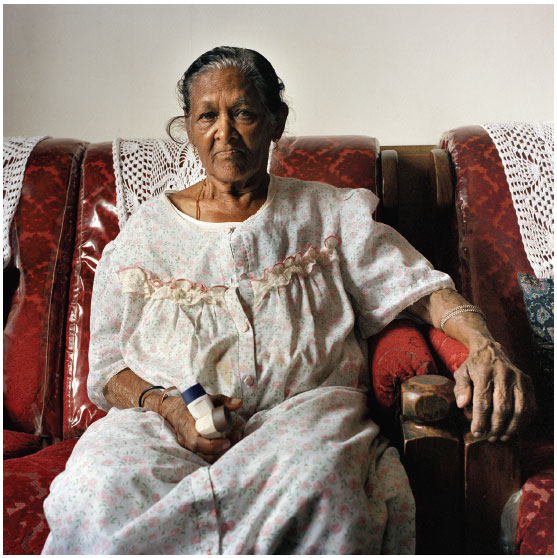
Hafiza Reebee at home in Shillong Road, Merebank. Night-time emissions from nearby industry left many people wheezing and exhausted after asthma attacks in the morning. Mrs Reebee has since died.
Photograph: Jenny Gordon, September 2003.
'The way she'd been suffering the whole night... when they have an attack, they cough and cough and cough. If you look here, can you see this chest bone here? Can you see it's swollen? This happens when they cough too much. And there's so much of pain. Because I experienced that with my husband. Because you feel like needles are poking you here. Because of the vibration of the chest when you're coughing. So you can see she's been really suffering this lady.... With me now, the moment I look at this picture, my eyes goes on her face and her chest. And I can see that illness is there... and the way her mouth is, you know when a person is angry and they don't know what to say, that's the way her face looks to me. She is so angry and she just doesn't know what to do with her frustration.' (Mrs V Perumal, neighbour and community health volunteer.)
Interviewed by Marijke du Toit, 9 March 2006.
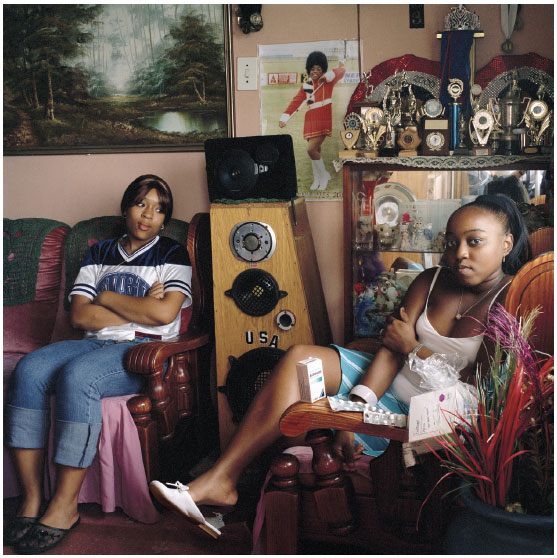
Latasha Webster (right), and her cousin Lucinda Booysen. For most of her life, Latasha has fought auto-immune hepatitis, a condition in which the immune system is compromised and which may be caused by environmental factors. She also has chronic asthma. Major Calvert flats, Austerville.
Photograph: Jenny Gordon, July 2004.
'My cousin, the way she's looking at me, it looks like she's just fed up and sad. Because she's close to me and she also feels it's enough now... but I'm not looking depressed or sad. I don't let people - it's something that doesn't ever worry me. Sometimes I even forget about my medication. You can see all my drummie awards, it's an exciting sport... it keeps you away from a lot of violence and bad things that are happening.' (Latasha Webster.)
Interviewed by Marijke du Toit, June 2007.
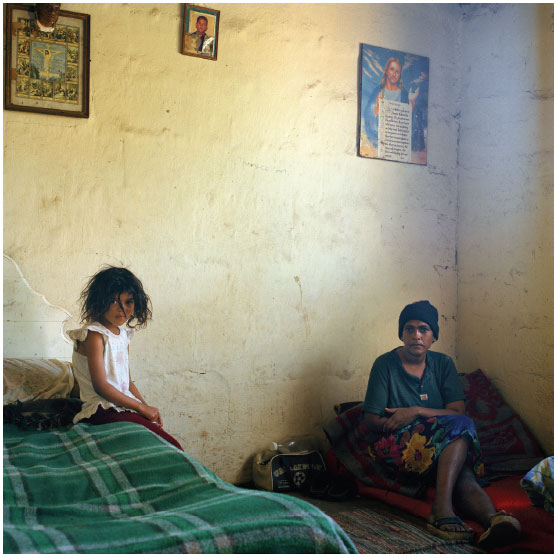
Jacky Davids and her daughter Nicole at home in Croton Road, Wentworth. Jenny had been taken there by home-based care volunteer George Ruiters, because all of the adult household members were unemployed and electricity and water had been cut for many months.
Photograph: Jenny Gordon, January 2005.
Interviewer: Does the picture show Nicole like you think of her?
Jennifer (Nicole's aunt): She looks different now. She's no more like that. She always when you tie her hair she opens it, loosens it and she runs around like that.
Interviewer: Oh, so she's a wild one?
Jennifer: She talks a lot. You must see her now. She can talk like a big lady!
Interviewer: You were saying you didn't quite like your picture?
Jacky: I'm so black there (laughter)
Jennifer: Now who's going to know it's you?! (Laughter.)
Toddler: Black, black, Jacky, you're black!
Interviewed by Marijke du Toit, 20 July 2006.
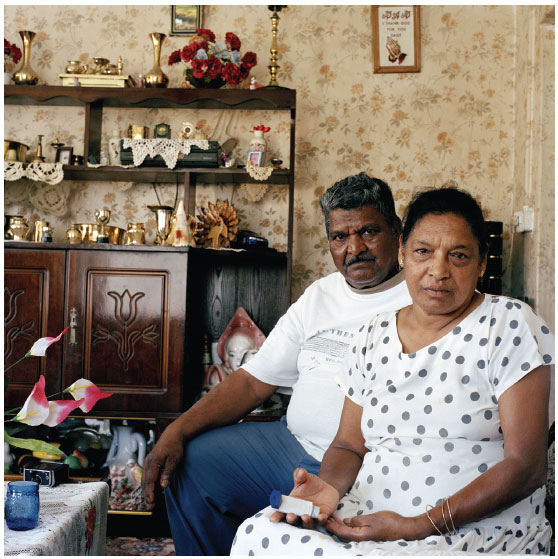
Premi Govender and her husband Gopal at their home in Dinapur Road, Merebank, which is less than 500 metres from the Engen Oil Refinery. Gas emissions from one or other of the nearby industries (Engen, Sapref or Mondi) the previous night had precipitated asthma attacks for them and many neighbours on the morning when this photograph was taken. Mr Govender died of a heart attack in 2005.
Photograph: Jenny Gordon, September 2003.
'For me the picture is very sad because I'm sick... sometime if the pump finish I've got nothing to breathe for, then I'm suffering. Ask anybody who can lend me a pump, or give me tablets. My granddaughter also suffer, my son suffer. I was a working woman, a fit woman... but now we're sick, we're suffering. I'm sitting here that's so sad that I'm sick, though I have a nice little house but my sickness you know, that happiness of the house just goes, you understand? I really love this place, and if they tell me to move somewhere else I'll have to go because of my sickness, but I will still have the memory of this place.' (Premi Govender.)
Interviewed by Marijke du Toit, September 2004.
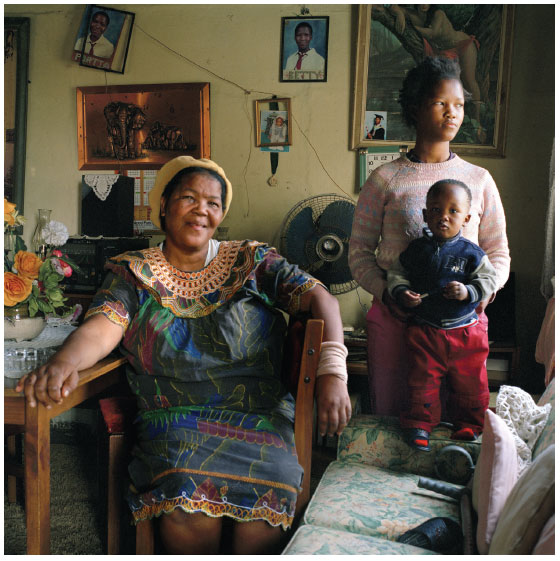
Nomsa Molly Malinga with her daughter Senzi and grandson Bongani, at their home in Pungula Avenue, Gijima, Lamontville.
Photograph: Jenny Gordon, July 2005.
'When I see my granny like this, I kind of remember all of the sisters, you get that warm fuzzy feeling when you see them together. Kodwa (but) when she's alone... ya yena, but when they're together. She teaches me a lot of things, sometimes we just sit and she'd open a family album, tells me a lot of things that I don't know from way back. She's like an ancient person with ancient stories. Ama-adventures from her life... there's drama, there's everything.' (Granddaughter Lindi Malinga.)
Interviewed by Marijke du Toit, 6 June 2007.
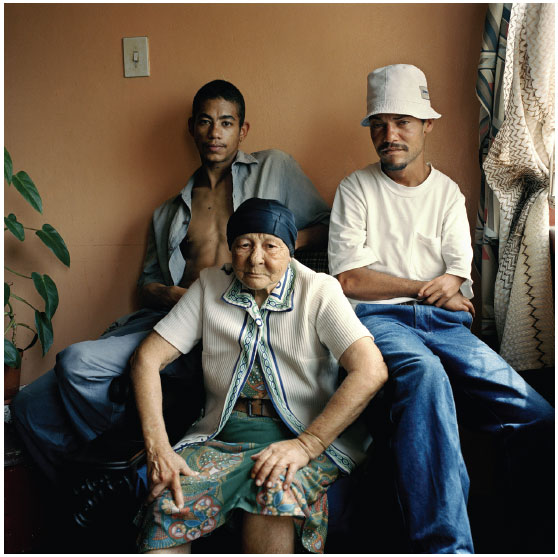
Olga Labuschagne, her grandson Quinton and his friend Peter, in her flat, Hime Street, Austerville. Mrs Labuschagne has since died.
Photograph: Jenny Gordon, September 2003.
'Quin always comes with strange people's sons here. And I don't chase them. When he comes here he makes me happy too. When I go into the kitchen then he talks nonsense and makes me laugh. At least he's my little company. And he always comes with a friend of his and I don't chase the friends... I don't like to chase people's children because I was also in St Philomena's school you see, in the orphanage school, there in Malvern. My mother put all of us there in the boarding school. She used to give what she can afford to the nuns.' (Olga Labuschagne.)
Interviewed by Marijke du Toit, July 2004.
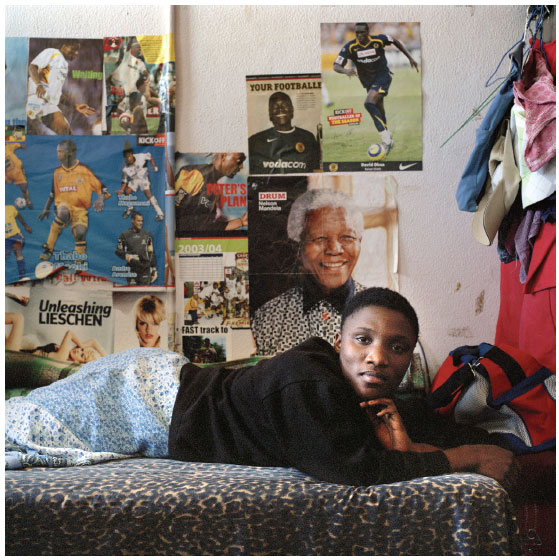
Dudu Dlamini at the 'Wema' (SJ Smith Migrant Labour Hostel), Lamontville. Jenny Gordon and Marijke du Toit were taken to the hostel by concerned Lamontville residents to assist female hostel dwellers who were organising to improve conditions for women.
Photograph: Jenny Gordon, July 2006.
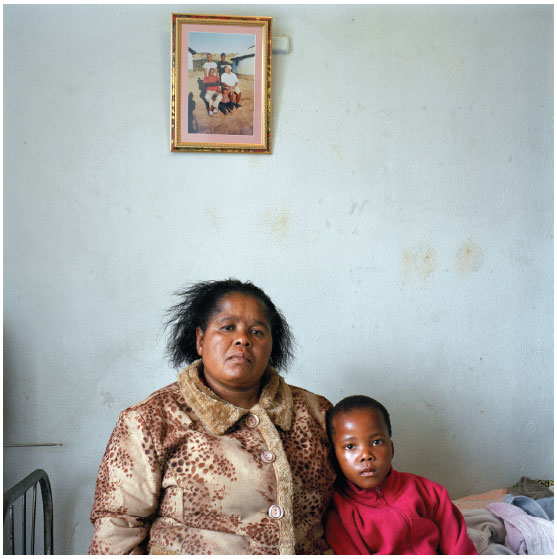
Rose Zibuyile Thabethe and her niece Ayanda in the room she shared with four men at the 'Wema' (SJ Smith Migrant Labour Hostel), Lamontville. She has since married and moved to a house in Lamontville.
Photograph: Jenny Gordon, July 2005.
'I was suffering when I was living here. You could only have a bed if you were with a man. I didn't want this any more (mina ngangisafuni ukuhlala nomuntu wesilisa, nga' sengikhathele ukuhlala nabantu besilisa eWema). So I'd moved to my brother's room and was sharing with his children. I could not sleep, liquor was sold at night. I'm a voluntary health worker in the community, I would maybe fall asleep at 1 am.' (Rose Thabethe.)
Interviewed by Marijke du Toit and Jabulile Ngcobo, 22 November 2008.
Translated from isiZulu.
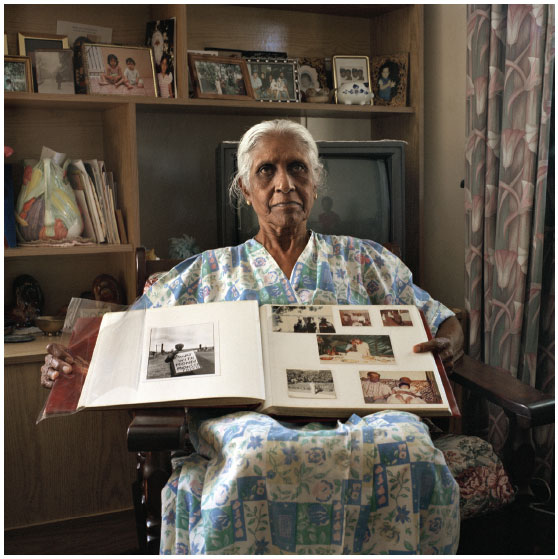
Mrs Mari, well known in Merebank for her activism against apartheid, at home in Alwar Road. She shows a photograph from the late 1980s of herself participating in a protest against Mondi, the paper manufacturer, because its trucks had been driven along the roads of residential areas.
Photograph: Jenny Gordon, September 2003.
'You know when I look at this picture (in the album), then I think about what we was striving for. For a better education, for better work and for better home. Nothing came up. That was my hurt. They said that they will see to free education, they will see to people that get job, and they will see to the people who haven't got a home. That's what the ANC promised. How can they turn things so bad? We're ok you know, but the people of Umlazi and Lamontville, they're the ones who suffer. With all we say the apartheid is over, it is not over now. It's not over at all.' (Mrs Mari.)
Interviewed by Marijke du Toit, 16 May 2005.
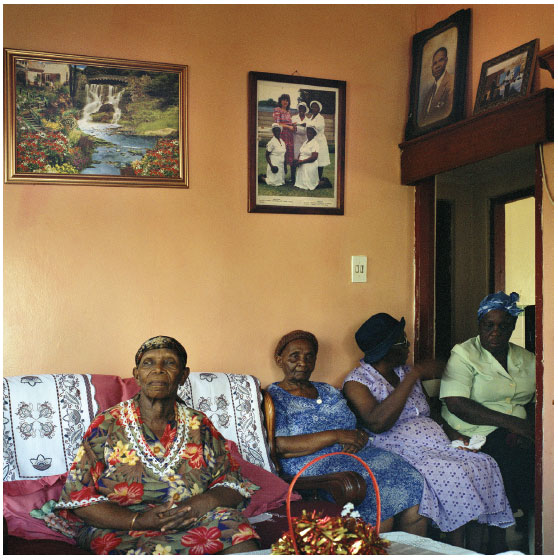
Gertrude Ngubane and friends. Her husband Louis (his portrait is above right), municipal councillor for the IFP in the late 1970s, went to Pretoria to ask National Party minister Piet Koornhof for permission to start a bowling club. She was also municipal councillor for the IFP in the 1980s, at the time of bitter conflict between the IFP and UDF.
Photograph: Jenny Gordon, March 2007.
'Anybody who was a member of the ANC don't even know what it was. In fact it is my request that they honour my husband's bowling green. It was the first of its kind to be played by Africans.' (Gertrude Ngubane.)
Interviewed by Marijke du Toit, June 2007. Additional information from Jabulile Ngcobo.
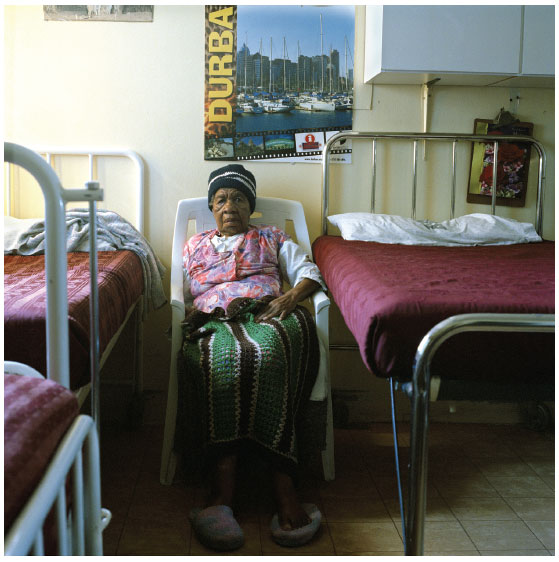
Elder Madondo at the Issy Geshwin Old Age Home, Ndlwana Road, Lamontville. Born in Estcourt, she used to do domestic work in Durban.
Photograph: Jenny Gordon, July 2005.
'When I look at this photo what comes to my mind is that I was beautiful. Did you ever see my pass book? I was very beautiful then! This comes after but I was very beautiful. Now I am ill and worn out.' (Elder Madondo)
'Uma ngibuka lesi sithombe kufika kumina ukuthi ngangimuhle. Nikhe nibone ipasi lami? Ngangimuhle kabi! Ngangimuhle impela. Loku kalandela. Kalandela ukuthi ngiyagula sengikhawulile.'
(Elder Madondo)
Interviewed by Marijke du Toit and Jabulile Ngcobo, 21 November 2008.
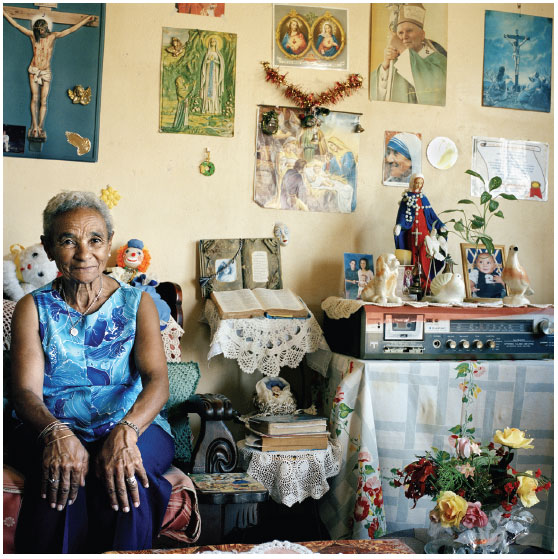
Dulcie Marnce in her lounge at Quality Street Flats, Austerville. She spends much of her day keeping bedridden residents at the nearby frail care home company.
Photograph: Jenny Gordon, December 2003.
The view towards the Engen Oil Refinery as seen from the third-floor council flat of Jimmy Davis in Alabama Road, Wentworth. Residents were using the space in front of the Alabama Road flats to repair fridges and cars. Behind the refinery one can see the ridge and the greenery that served as a buffer zone between the 'white' Bluff and 'Coloured' Wentworth when apartheid Group Areas legislation was still in place.
Photograph: Jenny Gordon, July 2004.
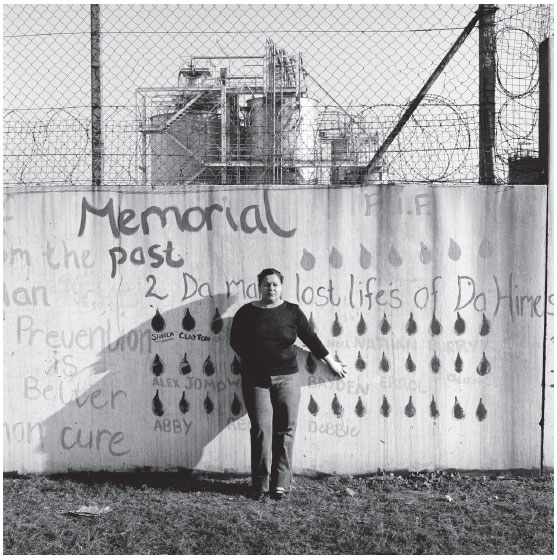
Lorna McDonald at the Memorial Wall, near the Hime Street flats, close to where she lives in Hydra Road, Austerville. She is touching the name of her brother.
Photograph: Jenny Gordon, November 2004.
'The Memorial Wall was started by residents who felt that the youth of Hime Street needed to know the names of lost loved ones so that they would not resort to violence or allow themselves to become victims of crime. My brother Baden Bridger was murdered on 12 November 1981. Our family was fortunate, the murderer was sentenced to 12 year's imprisonment.' (Lorna McDonald.)
Explanation given by Lorna McDonald to Marijke du Toit (handwritten, 8 January 2009). Lorna was a photography workshop participant in 2003 and assisted us with introductions to people in her neighbourhood.
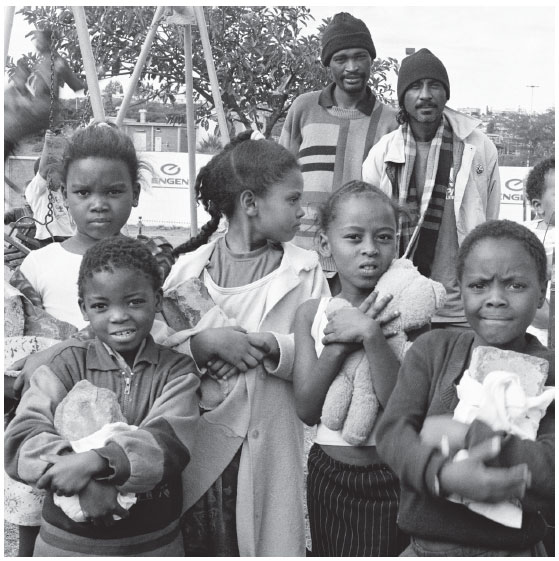
Chenece, Anita, Precious and Faith, with Michael and Mervin standing behind them. They were playing near the council housing known locally as 'The Barracks', in Tara Road, Wentworth.
Photograph: Jenny Gordon, July 2002.
'What is it that people find depressing, is it that these children have got bricks? The stone says so much, it's a child thing. As they're going along and playing, there comes a time when they say, oh, I think my child has peed, I need to change her. Seriously! And they would put this brick down and open the blanket... and like these two guys above them... they're also two gentlemen, they mean no harm to anyone. They're very subtle. They know who they are, you know. They know that... Mervin is into fishing. That's his livelihood. Michael is into maintenance work.' (Bernadette Saunders, resident of 'The Barracks'.)
Interviewed by Marijke du Toit, 8 June 2007.
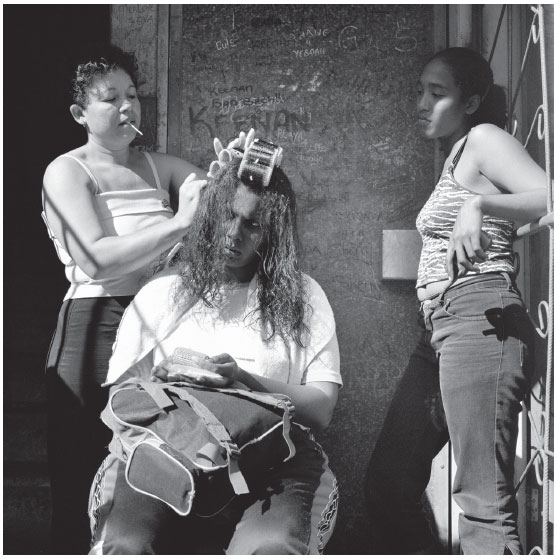
Ursula Pechey rolling her neighbour Fazila's hair at the Hime Street flats, Austerville. No money exchanges hands as they use a bartering system. Fazila might opt to do any favour, e.g. pedicure, for Ursula in exchange for a hairdo. With this system, you could feel as if you spent the day at a spa being pampered, if you do enough favours.
Photograph: Jenny Gordon, January 2003.
Caption composed by Fazila's sister Lorna McDonald (Merebank Photography Workshop participant - her own photographs appear elsewhere in this exhibition.)
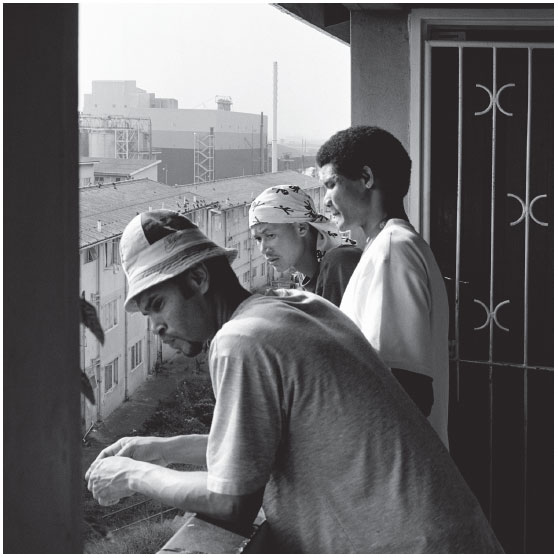
Vernon Naicker, Jonathan Parker and Michael Blackburn on the balcony of the flat in Hime Street, Austerville, where Jonathan lives.
Photograph: Jenny Gordon, July 2003.
'I don't have to look long at this picture to figure out what it's all about. It is actually about the closeness of the factories to the residential areas... if you go to this factory you'll find out that most of the people who work here are not even living here, are not even from anywhere near here. Half of the guys can't get work right here. This picture could be also based on friendship. That one there is my brother-in-law, and this is my cousin. We're almost like family, but we're more of friends. Together in the struggle. Because the background does look like a struggle.' (Jonathan Parker.)
Interviewed by Marijke du Toit, 5 July 2007.
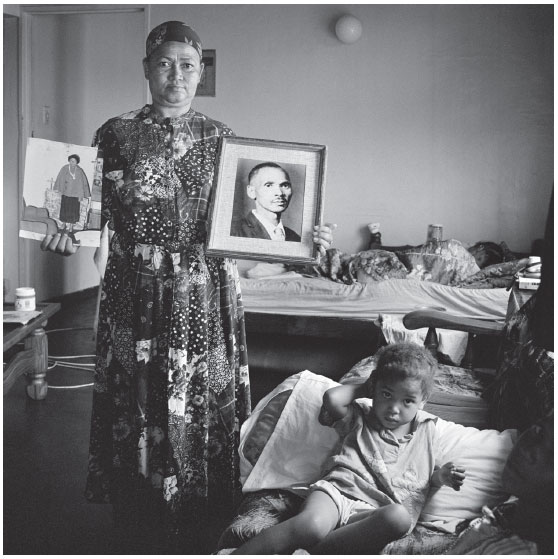
Sylvia King at home in Hime Street, Austerville, with her gravely ill daughter and her granddaughter, holding the portraits of her parents.
Photograph: Jenny Gordon, January 2003.
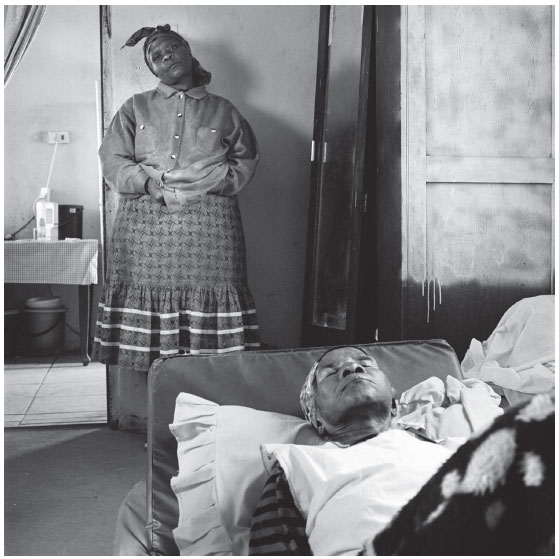
Mrs Hlekani Mngade of Ntuli Street, Lamontville, and a relative. Jenny Gordon had accompanied care-giver Sibongile Gumede of the organisation Muthande Society for the Elderly on a home visit.
Photograph: Jenny Gordon, July 2005.
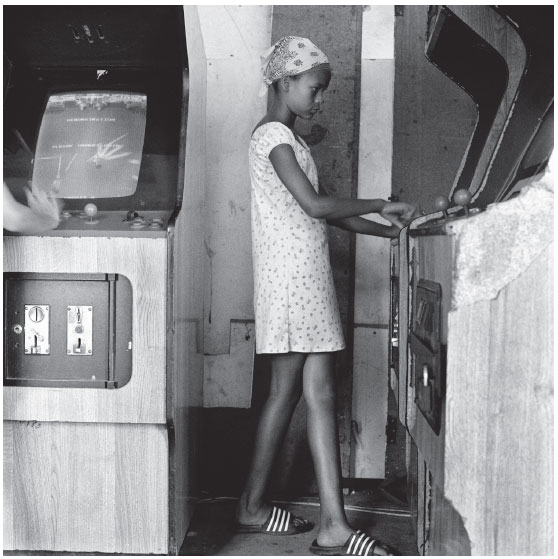
Roslyn Crosley in the small game shop near her home at 'The Barracks', Tara Road, Wentworth.
Photograph: Jenny Gordon, January 2003.

Philipina Sayed in the tuckshop at her home in Reiger Road, Wentworth. As a young woman, she worked as a live-in domestic worker in one of Durban's 'white' suburbs. She used to be classified African according to apartheid-era legislation, and lived with her partner of Indian descent for many years before they were able to marry.
Photograph: Jenny Gordon, July 2003.
'We called it the blackjacks, the cops, they wore a black uniform and moved around in the night. They want to send you back. Whoever hired you, the white lady, you had to be registered. Then you have to work there... you can't marry then, the nation you not belong to. Like I'm born a Mlaba... I only married in 1990. We stayed in Bellair. I lived in Indian area. We stayed together but we couldn't get married. So it was a very hard time... you couldn't make a business for yourself that time. But what you made, it was enough.' (Philipina Sayed.)
Interviewed by Marijke du Toit, 8 July 2008.
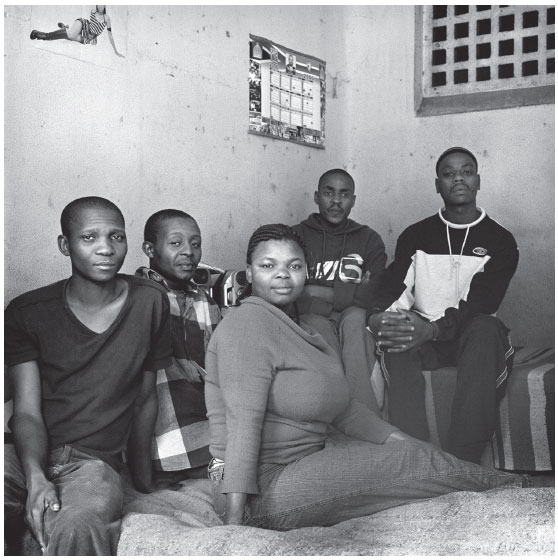
Wiseman Slangane (left) sits next to Gugu Sabiso and Mandla Skhosana on one of the ten beds in their room. Two friends, who also live in the 'Wema' (SJ Smith Migrant Labour Hostel), were visiting. In front is Makhosi Nxumalo, partner of roommate Zwa Gwala.
Photograph: Jenny Gordon, July 2006.
'I need this picture, I love it. Kahle kakhulu (it's beautiful). She is my wife, my Makhosi. These are my friends. Siyazwana (we feel for each other). I need this snap. Because it can show me the long language, it gives umlando omningi (much history), long story. You see when you stay like this, with someone you love, it is hard.' (Zwa Gwala.)
'But they're so very serious because of suffering, hey. I know all the life of these guys. It's because I know that this guy is not working, and this brother - he's here for a job.' (Room companion Xolani Ngcobo.)
Interviewed by Marijke du Toit, 23 June 2007. An English translation of the spoken isisZulu is given in parenthesis.
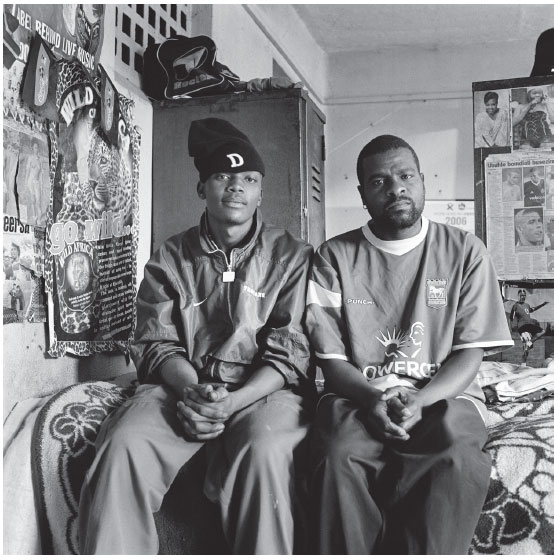
Xolani Ngcobo (left) and Thulani Gasa in their 10-bed room at the 'Wema' (SJ Smith Migrant Labour Hostel).
Photograph: Jenny Gordon, July 2006.
'By the time you were taking this photo I was not working. But now I'm taking a temporary job. I don't have a certificate of that job. I'm working on a site. I was looking for work for three years. There's a lot of beds here you know. And me too I don't like it. I want to sleep alone in my own room.' (Xolani Ngcobo.)
Interviewed by Marijke du Toit, 23 June 2007.
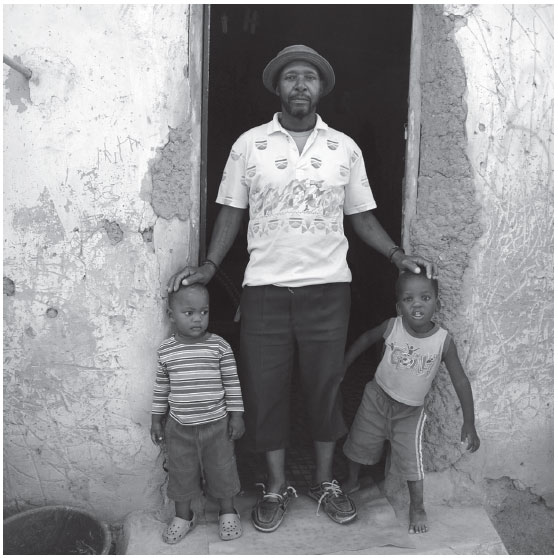
Zonele Mdunge at the Emoyeni informal settlement, Gijima, Lamontville, with his grandchildren Ntando (left) and Sanele. The children mostly live with their grandparents. Chairperson of the local residents' committee, Mr Mdunge has since moved to one of Lamontville's 'Tintown' transit camps, as the eThekwini Municipality plans to build permanent homes at Emoyeni. He arrived in Durban from Ixopo in 1958, and mostly worked at local factories before retiring. He has lived at Emoyeni for 16 years.
Photograph: Jenny Gordon, March 2007.
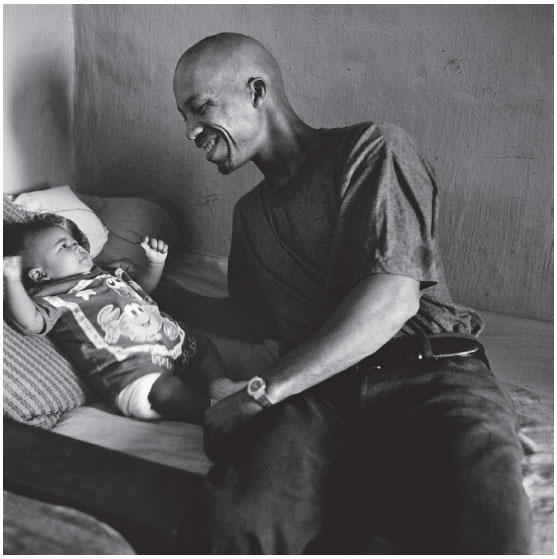
Martin Sewell with his son at his flat in Hime Street, Austerville.
Photograph: Jenny Gordon, July 2003.
MARIJKE DU TOIT lectures in History at the University of KwaZulu-Natal. Her research interests include a focus on South Africa's visual economy of the early twentieth century. She has published articles that explore how popular photographies contributed to the articulation of racialised identities, particularly as regards Afrikaner nationalism. She has also written about South African sociologists' use of kodak camera photography in the 1920s and 1930s, as part of their research. Her interest in public, local and oral history led to collaboration with Jenny Gordon on the Durban South Photography Project.
JENNY GORDON lectures photo-journalism at the Rhodes School of Journalism and Media Studies. She spent five years as Director of the Market Photography Workshop in Johannesburg and also arranged workshops for developing photo-journalists for World Press Photo. She has taught at UCT, UWC, City Varsity and Allenby College. Her freelance career spans over 25 years and her photographs have been published in many books, magazines, newspapers and on the web. She has exhibited in South Africa, Europe and America.
1 For a longer history of industrial growth in South Durban, see Stephen Sparks, 'Playing at public health: The search for control in South Durban1860-1932', Journal of Natal and Zulu History, volume 20, 2002. [ Links ] See also S Sparks, ''Stink, maar uit die verkeerde rigting': Pollution, politics and petroleum refining in South Africa, 1948-1960' (unpublished M.A dissertation, University of KwaZulu-Natal, 2004. [ Links ] See also Louise Torr's 'Lamontville, Durban's model village: The realities of township life, 1934-1960', Journal of Natal and Zulu History, 1987. [ Links ]
2 Brij Maharaj details the Durban City Council's 'critical role in the formulation, refinement and implementation of the Group Areas Act'in 'The 'spatial impress'of the central and local states: The Group Areas Act in Durban'. in David Marshall Smith, ed. The Apartheid City and Beyond: Urbanization and Social Change in South Africa (London: Routledge; Johannesburg : Witwatersrand University Press, 1992). [ Links ] Histories of the implementation of racial segregation of South Durban include D Scott's 'Creative destruction: Early modernist planning in the South Durban Industrial Zone, South Africa', Journal of Southern African Studies 29: 1, 235-259. [ Links ] See also her doctoral study, 'The rise and fall of Clairwood and District', (University of Natal, 1994). [ Links ]
3 Environmental activists from these neighbourhoods sometimes trace the beginning of their struggles against industrial pollution to the 1960s, with their opposition gathering force during the 1980s, although Stephen Sparks traces a longer history of local residents' efforts to draw the municipality's attention to high levels of air pollution in 'Stink maar uit die verkeerde rigting'. See also B. Freund, Brown and green in Durban: The evolution of environmental policy in a post-apartheid City, International Journal of Urban and Regional Research 25, 4, 2001; [ Links ] D. Wiley, S. Root and B .Peek, Contesting the urban-industrial environment in South Durban in a period of democratisation and globalisation in B. Freund and V Padayachee,, eds, Durban Vortex: South African City in Transition (University of Natal Press, Pietermaritzburg, 2002). [ Links ]
4 See, for example, D. Wiley, S. Root and B. Peek (1992); S. (Bobby) Peek, 'Double-speak in Durban: Mondi, waste management and the struggles of the South Durban Community Environmental Alliance', in David A. McDonald, ed., Environmental Justice in South Africa (Athens: Ohio University Press ; Cape Town : University of Cape Town Press,, 2002). [ Links ]
5 The first workshop was held in Austerville/Wentworth, in 2002. High school students from local schools participated. The second workshop (2003) involved high school students from Merebank and also members of civic organisations and community health volunteers from Wentworth. The majority of participants in the third workshop were high school students from Lamontville. Community health volunteers and teenagers from Wentworth and Merebank also participated. We discuss our approach to teaching the workshops in 'The means to turn the social key: The South Durban Photography Project's workshops for first-time photographers (2002-2005).' Published in Naydene de Lange et al, eds, Putting People in the Picture: Visual Methodologies for Social Change (Rotterdam:Sense Publishers, 2008). [ Links ]
6 Doon Arbus 1972. Going Where I Have Never been [film] [ Links ].
7 David Hurn and Bill Jay, On Being a Photographer: A Practical Guide ( Anacones WA: LensWork Publishing 1997):12. [ Links ]
8 David Hurn and Bill Jay, (1997): 33.
9 Geoff Dyer The Ongoing Moment (Westminster, MD: Pantheon Books, 2005):5-6. [ Links ]
10 David Hurn and Bill Jay (1997) 37. [ Links ]
11 Jodie Bieber, Real Beauty,The Goodman Gallery, Johannesburg, November-December 2008. [ Links ]
12 David Hurn and Bill Jay, (1997): 38. [ Links ]
13 David Levi-Strauss, Between the Eyes: Essays on Photography and Politics (New York: Aperture 2005,:8) . [ Links ]
14 Ibid.
15 Ibid.
16 Geoff Dyer (2005): 17. [ Links ]
17 This is a medium format camera that takes square format photographs.
18 Bill Jay and David Hurn (1997):2. [ Links ]
19 David Levi-Strauss (2005)::9. [ Links ]
20 Ibid: 7-8.
21 Photo elicitation is well established as a qualitative research method in a range of disciplines. See, for example, Christopher John Pole, Seeing is Believing? Approaches to Visual Research (Bingley BD: Emerald Group Publishing, 2004) and D Harper, [ Links ] 'Talking about pictures: A case for photo elicitation' (Visual Studies, Volume 17, 1). [ Links ] 'Photovoice' as a participatory action research method and as a strategy for qualitative research has become popular in such fields as health, psychology, education and management. Participants document aspects of their own lives and often also participate in interviews about the photographs or produce text alongside the photographs. See also the advocacy work of the non profit organisation PhotoVoice (www.Photovoice.org) For South African examples, see de Lange et al, Putting People in the Picture (2008). [ Links ]Many photovoice projects have involved visual displays that combine quotes from interviews and photographs by participants.













